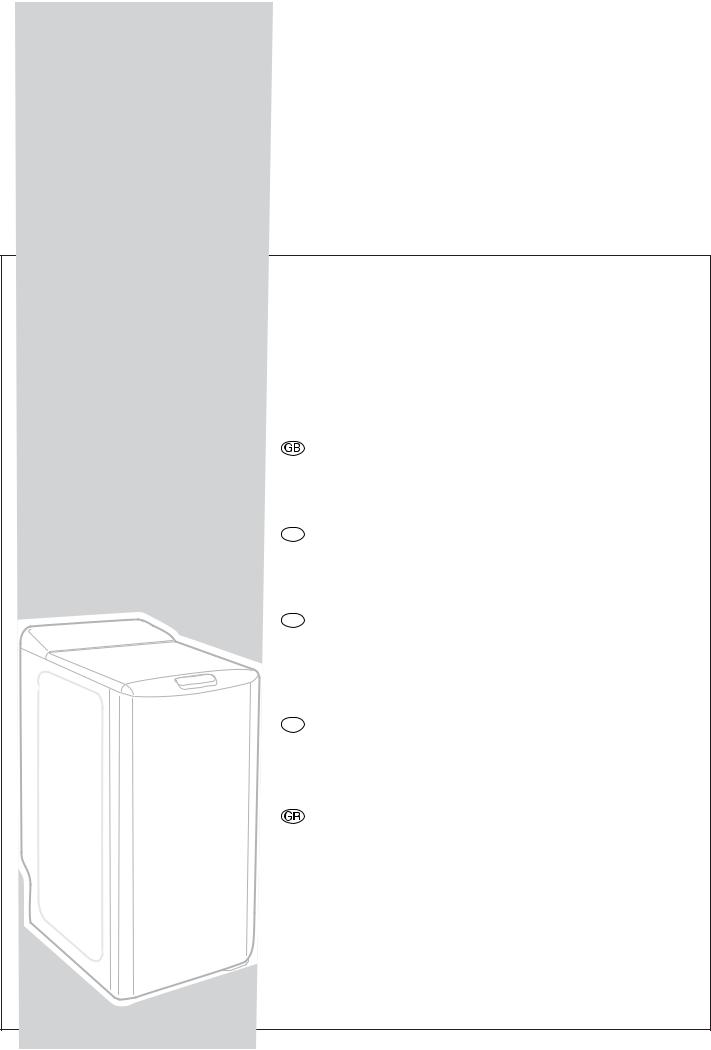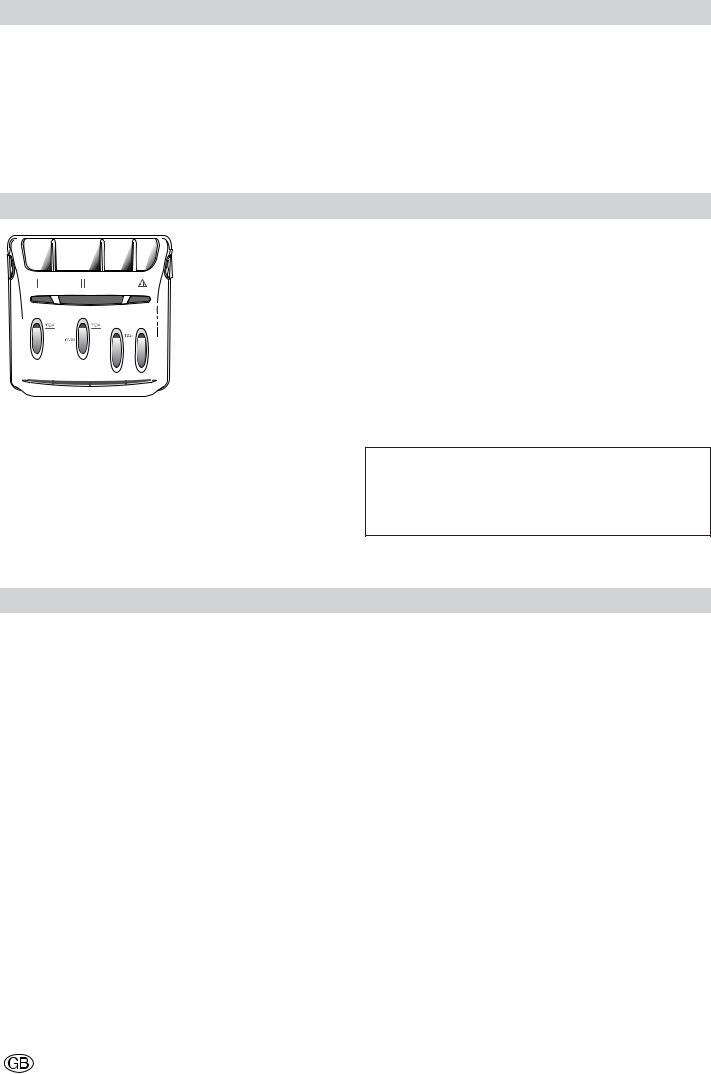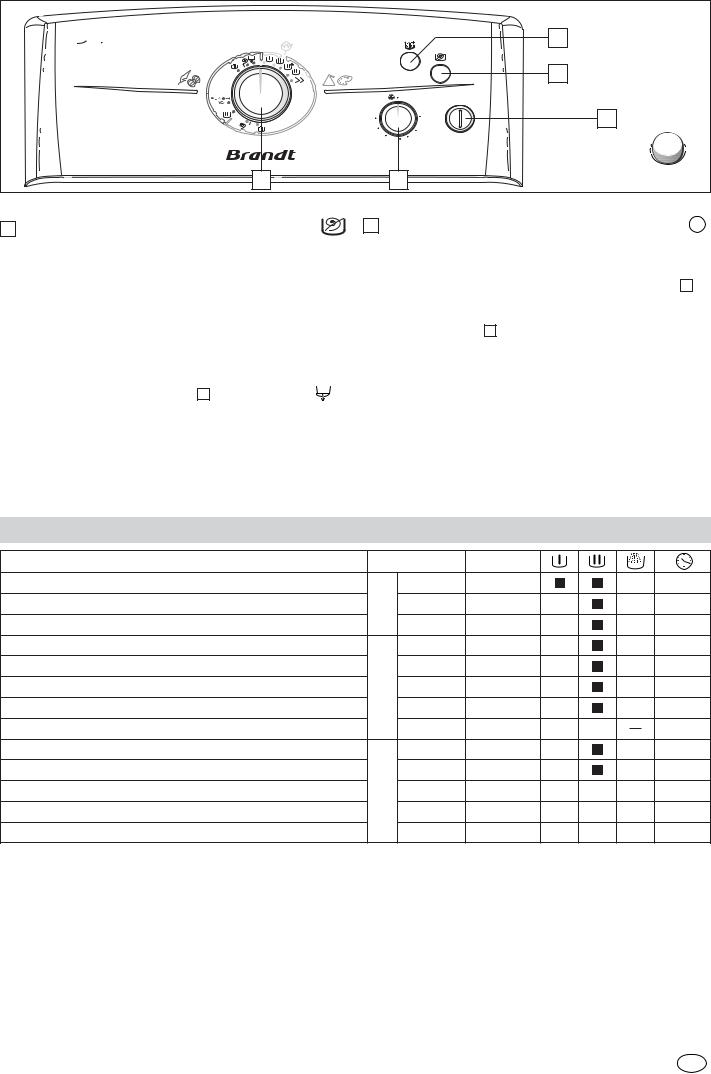BRANDT WTC0611E User Manual [fr]

WASHING MACHINE
LAVE-LINGE
WÄSCHMASCHINE
LAVADORA
MÁQUINA DE LAVAR
ROUPA
VASKEMASKINE
WASMACHINE
PRALKA
AUTOMATICÁ PRAČKA |
INSTALLATION, OPERATING AND |
|
MAINTENANCE INSTRUCTIONS ................Page 3 |
CT PA HA
MA HA
ΠΛΥΝΤΗΡΙΟ ΡΟΥΧΩΝ
F MANUEL D’INSTALLATION, |
|
D’UTILISATION ET D’ENTRETIEN |
..............Page 7 |
EMANUAL DE INSTALACIÓN, DE INSTRUCCIONES DE USO
Y MANTENIMIENTO .................................. |
Página 11 |
P MANUAL DE INSTALAÇÃO, |
|
UTILIZAÇÃO E MANUTENÇÃO .............. |
Página 15 |
Ο∆ΗΓΙΕΣ ΕΓΚΑΤΑΣΤΑΣΗΣ, |
|
ΧΡΗΣΗΣ ΚΑΙ ΣΥΝΤΗΡΗΣΗΣ |
....................Σελίδα 19 |

You will find the following symbols used throughout this manual. They mean :
Safety instructions (for your machine and your washing), which must be observed
An electrical risk,
Important advice and information
FAu fil des pages de cette notice, vous découvrirez les symboles suivants qui vous signaleront :
les consignes de sécurité (pour vous, votre machine ou votre linge) à respecter impérativement,
un danger électrique,
les conseils et les informations importantes
DIm Laufe der Seiten geben folgende Symbole Hinweise auf:
die Sicherheitsvorschriften (für Sie, die Maschine oder die Wäsche), die unbedingt eingehalten werden müssen,
eine elektrische Gefahr,
Tipps und wichtige Informationen.
EA lo largo de las páginas de este manual, descubrirá los símbolos siguientes que le señalarán :
las consignas de seguridad (para usted, su máquina o su ropa) que respetar de modo imperativo,
un peligro eléctrico,
los consejos y las informaciones importantes
Door deze handleiding heen zult u de volgende symbolen aantreffen die u aangeven :
de veiligheidsvoorschriften (voor u, uw machine of uw was) die absoluut moeten worden nageleefd,
gevaar van elektrische aard,
tips en belangrijke informatie
W treści instrukcji można znaleźć poniższe symbole. Oznaczają one:
Instrukcje bezpieczeństwa (odnoszące się do pralki i procesu prania), które muszą być przestrzegane
Instrukcje bezpieczeństwa dotyczące instalacji elektrycznej
Ważna porada i informacja
CZ Na dalších stránkách tohoto návodu naleznete následující symboly, které vás upozorňují na:
Bezpečnostní doporučení (pro vás, pro vaši pračku a vaše prádlo), kterými je třeba se bezpodmínečně řídit,
Nebezpečí zásahu elektrickým proudem,
Doporučeni a důležité informace
, :
( ,),,
,
! .
PAo longo das páginas deste manual, descobrirá os símbolos seguintes que assinalam :
as instruções de segurança (para si, a sua máquina ou a sua roupa) a respeitar imperativamente,
um perigo eléctrico,
os conselhos e as informações importantes
DK I denne betjeningsvejledning vil De støde på følgende symboler, som betyder:
Στις σελίδες που ακολουθούν θα ανακαλύψετε τα παρακάτω σύµβολα τα οποία επισηµαίνουν:
τις οδηγίες ασφαλείας (για σας, το πλυντήριο ή τα ρούχα σας) που πρέπει οπωσδήποτε να τηρείτε.
ηλεκτρικό κίνδυνο
τις σηµαντικές πληροφορίες και οδηγίες
Sikkerhedsregler (for Dem, maskinen eller vasketøjet), som skal overholdes.
Elektrisk fare
Vigtige råd og oplysninger
- 2 -

Removing the transport clamps from your machine see diagrams D1-D2-D3
BEFORE USING THE MACHINE IN ANY WAY, YOU MUST FIRST PERFORM THE FOLLOWING OPERATIONS.
These comprise removing all the components designed to immobilise the drum in your machine during transport.
These so-called “releasing” operations are necessary for your machine to operate correctly and to conform to the prevailing safety standards.
If they are not carried out completely, this could cause severe damage to your machine while it is operating.
1 - Remove the washing machine from its plinth (check that the wedge supporting the motor is not still inserted in the machine) (Diagram D1. )
2 - Remove the 4 screws with a screwdriver (Diagram D1. )
3 - Remove the cross clamp by removing the 2 screws (Diagram D1. ) using a 10 or 13mm spanner (depending on the model). (Ensure that you remove the two plastic braces fixed on the cross clamp at the same time as the clamp itself).
Replace the screws in their initial positions.
4 - You must block off the two holes using the hole covers provided (supplied in the accessories bag) (Diagram D1. )
5 - Remove the drum-tank assembly locking wedge (Diagram D2). To do this:
-Lift the lid on the machine
-Remove wedge
-Remove wedge by turning it a quarter turn
-Release the drum doors, locked in the lower position, by pressing down on both eaves simultaneously.
6 - Remove the pipe support collars You must block off the holes revealed with the hole covers supplied in the accessories bag (Diagram D3).
We would recommend that you keep all the locking components since these must be refitted if you must subsequently transport your machine again.
All these components, just like all the components in your machine, are made of recyclable materials and it is useful to bear this in mind when you eventually come to dispose of your machine at the end of its useful life.
Your machine has been scrupulously checked before it left the factory. You may therefore notice a little water still remaining in the tank or the products box.
Installing your machine
Mounting it on castors:
If your machine is equipped with removable castors, you will be able to move it quite easily.
To mount it on castors, swivel the lever on the bottom of the machine from the right to the far left (Diagram D4).
The machine must not rest on the “front” castors while it is operating: remember to return the lever to its initial position.
Levelling the machine:
Use a spirit level to check that the floor is horizontal: maximum slope 2°, i.e. a discrepancy of approximately 1cm over the width and of 1.5cm over the depth of the machine.
see diagram D4
Your machine’s surroundings:
If you are installing your machine next to another machine or a unit, we recommend that you leave a gap between them to allow for air circulation.
We also strongly recommend that you do NOT:
-Install your machine in a damp, poorly ventilated room.
-Install your machine in an area where it could be subject to water splashes.
-Install your machine on a carpeted floor.
If you cannot avoid doing this, please take every precaution to avoid blocking air circulation at the bottom of the machine in order to ensure that the internal components are well ventilated.
Connecting your machine
Connecting the cold water supply
Connect the supply hose (Diagram D5) :
-At one end to the connection on the back of the machine
-On the other end to a tap fitted with a threaded end 20mm dia. x 27 (3/4 BSP).
If you use a self-piercing tap, the useful aperture must have a minimum diameter of 6mm.
Water supply:
-Minimum water pressure: 0.07 MPa or 0.7 bar
-Maximum water pressure: 1 MPa or 10 bars
Draining away the waste water
Fit the hose bracket provided inside your machine to the end of the drain hose and then connect the hose (Diagram D6) :
•Either, temporarily, over a sink or a bathtub.
•Or permanently to a ventilated U-bend.
If your installation does not have a ventilated U-bend, check that the connection is not sealed. In fact, to avoid any waste water flowing back into the machine, you are strongly recommended to leave an air gap between the machine’s drain hose and the drainpipe.
In any case, the drain hose bracket must be placed at a height of 65 to 90cm higher than the base of the machine.
Ensure that the drain hose is tied firmly in place with cord to avoid the bracket coming loose during draining and causing a flood.
The waste water can be drained away to the ground provided that the drain hose passes through a point 65 to 90cm higher than the base of the machine.
see diagrams D5-D6-D7
On any new installation (following a move or resale, etc.), the machine must be connected using new hoses. The old hoses must not be reused.
For your safety, you must comply with the instructions below.
Electrical supply (Diagram D7)
•Before connecting your machine, you must ensure that your installation’s electrical characteristics match those of your machine (see the details provided on the information plate affixed to the back of the machine).
•The electrical installation must comply with the prevailing standards and the Electricity Board’s regulations in the country concerned, particularly as regards Earthing and installation in shower rooms.
We cannot be held responsible for any incident caused by the machine being incorrectly earthed.
Advice on the electrical installation of your machine
•Do not use an extension lead, adapter or multiple socket.
•Never cut out the Earth wire.
•The socket must be readily accessible but out of the reach of children.
If in any doubt, please contact your installer.
Your machine conforms to European Directives EEC/73/23 (Low Voltage Directive) and EEC/89/336 (Electromagnetic Compatibility) as modified by Directive EEC/93/68.
- 3 -

Loading your washing
Perform these actions in the following order:
Open the machine
•Check that the “Start/Stop”( ) button is released.
) button is released.
•Depending on the model, lift the opening handle or press the push button on the front of the machine.
The lid will open.
•Open the drum by pressing the button on the front door.
Insert your washing
For optimum washing performance, place your washing, preferably sorted and folded, in the drum, distributing it evenly without heaping it up. Mix large and small items to obtain an optimum, well-balanced spin.
Close the drum
Ensure that the drum is correctly closed.
Check that the three hooks and the border of the button are fully visible.
Loading the washing products
|
|
|
|
Pre-wash container |
|
(powder) |
|||
|
|
|
|
Wash container |
|
|
|
|
(powder or liquid) |
|
|
|
|
Softener |
|
|
|
cl |
Bleach |
|
|
|
|
: POWDERED |
|
|
|
|
DETERGENT |
|
|
|
|
: LIQUID |
|
|
|
|
DETERGENT |
The “WASH” container may contain powder or liquid but liquid detergent should not be used for programmes WITH Pre-wash and/or WITH “Delayed Start” (depending on the model).
Concentrated softener should be diluted with warm water.
Concentrated bleach must be diluted.
To fill the product containers correctly, place the lid fully open.
Do not exceed the MAX level.
Dispensing the detergent
The amount of detergent to be used depends on the hardness of the water, the extent to which your washing is soiled and the amount of washing to be washed.
Please refer to the dosing instructions on your pack of detergent. Warning: in most cases, the detergent manufacturer’s recommendations apply to the drum filled to the maximum. Adjust the dosage correctly to the weight of the washing you have placed in the machine.
These recommendations will help you to avoid using too much detergent, which causes foam to be produced. Too much foam can reduce your machine’s performance and increase the length of the washing cycle and the consumption of water.
Detergents for woollens and delicate fabrics
You are recommended to use an appropriate detergent for washing these fabrics (avoid placing such detergents directly on the drum because they have an aggressive action on the metal).
Before your first wash
Before making your first wash, we recommend that you carry out a “COTTON 90 wash without pre-wash” and with no washing in the drum, using a 1/2 measure of your usual detergent in order to eliminate any residues from manufacturing that may remain in your machine.
Automatic safety devices
Lid opening safety device:
As soon as the washing cycle starts, the lid on your machine will lock.
As soon as the cycle is finished, or when the machine has stopped with the drum full of water, the lid unlocks.
If you wish to open the lid during the cycle, release the “Start/Stop” button( ) and wait at least 2 or 3 minutes for the lid safety device to disengage.
) and wait at least 2 or 3 minutes for the lid safety device to disengage.
Selecting a washing programme
1 Selecting the type of washing __________________
Choose the most suitable programme for your type of washing.
COTTON 
If your washing consists of WHITES, COTTONS or LINEN
SYNTHETICS or COLOUREDS 

If your washing consists of COLOUREDS, HARD-WEARING SYNTHETICS or MIXED FIBRES
DELICATES and WOOLLENS 
If your washing consists of NET CURTAINS, DELICATE FABRICS, FRAGILE HOUSEHOLD TEXTILES or "MACHINE-WASHABLE WOOLS"
For more details, please refer to the programmes table on the following page.
Water safety device:
While the machine is operating the constant water level control system prevents your machine from overflowing.
Spin safety device:
Your washing machine if fitted with a safety device that can restrict spinning when it detects that the washing is poorly distributed.
In this case, your washing may be insufficiently spun. Redistribute your washing evenly in the drum and programme a new spin.
2 Selecting the temperature______________________
Choose the most suitable temperature for your type of washing. To do this, follow the instructions on the labels attached to most textiles.
Please refer to the meanings of the symbols at the end of this manual.
COTTON |
: from “cold” |
to 90°C |
SYNTHETICS and COLOUREDS : from “cold” |
to 60°C |
|
DELICATES and WOOLLENS |
: from “cold” |
to 40°C |
3 Extra rinse ______________________________
An additional programme for "sensitive and allergic skins".
It adds an extra rinse to the "Cotton" and "Synthetics and Coloureds" cycles.
Selecting this button has no effect during the “Delicates and Woollens” cycle.
- 4 -

1 |
5 Kg |
600 rpm |
|
|
|
3 |
|
Automatic Variable Capacity |
|
|
|
|
|
||
|
|
|
|
|
|
4 |
START |
|
|
|
|
|
|
BUTTON |
|
|
|
|
|
|
|
|
|
|
|
|
|
|
|
|
PRESSED |
|
|
90˚C |
|
|
30 |
|
5 |
|
|
|
|
|
|
|
|
|
|
80 |
|
|
40 |
|
STOP |
|
|
|
70 |
|
|
|
|
|
|
|
50 |
|
|
BUTTON |
|
|
|
|
60 |
|
|
||
|
|
|
|
|
|
|
RELEASED |
|
|
|
|
|
|
M A D E I N F R A N C E |
|
|
|
1 |
2 |
|
|
|
|
4 Full drum stop ____________________________ |
5 Start /Stop |
______________________________ |
|
|
|
||||
This function should be used for textiles that you do not wish to |
Check that the electrical power cable is connected and |
|||
spin or if you expect to be away for a prolonged period after the |
that the water tap is open. Also ensure that the drum doors and |
|||
washing cycle has finished. |
the machine’s lid are correctly closed. |
|||
When this button is selected, the cycle is interrupted before the |
Press button |
5 in when you have finished programming the |
||
final spin, allowing your washing to float in water to avoid |
machine. The washing cycle starts. |
|||
creasing. |
Once the cycle has finished, switch off the machine by releasing |
|||
Then: |
||||
button 5 . |
|
|
||
- If you subsequently wish to spin and drain. |
You can then open the lid and remove your washing. |
|||
Simply release this button |
Also release any other buttons you have selected. |
|||
The programme will finish automatically. |
As a safety precaution, we recommend that you disconnect |
|||
- Or if you wish just to drain. |
the power cable and turn off the water tap. |
|
|
Turn knob 1 to the " " position and release the button. |
|
Programmes examples
Type of washing |
Programmes |
|
|
|
90°C wash with pre-wash |
|
90 |
3 |
02 : 45 |
90°C wash |
|
90 |
3 |
02 : 30 |
ECO 40° or 60°C wash |
40 |
/ 60 |
3 |
02 : 30 |
Intensive 40° to 60°C wash |
40 |
→ 60 |
3 |
02 : 10 |
40° to 60°C wash |
40 |
→ 60 |
3 |
02 : 00 |
Cold to 30°C wash |
|
→ 30 |
3 |
01 : 50 |
Rinse & spin, cotton, synthetics and coloureds |
|
|
1 |
00 : 25 |
Spin, cotton, synthetics and coloureds |
|
|
|
00 : 15 |
Delicate fabrics cold to 40°C wash |
|
→ 40 |
3 |
00 : 50 |
Rapid wash, all textiles, at 30°C |
|
30 |
3 |
00 : 40 |
Rinse & spin, delicates & woollens |
|
|
1 |
00 : 15 |
Spin, delicates & woollens |
|
|
|
00 : 10 |
Drain |
|
|
|
00 : 05 |
Maximum loads
”Cotton” and ”Coloureds”: 5 kg. ”Synthetics” and ” 



 ”: 2.5 kg. ”Delicates and woollens”: 1 kg.
”: 2.5 kg. ”Delicates and woollens”: 1 kg.
STANDARD COMPARISON TESTING PROGRAMME
Programme ............................................................................ |
- |
Duration |
............................................................................................ 2 : 10 |
Temperature .................................................................................... |
60°C |
Energy. ...................................................................................... |
0.95 kWh |
Load .................................................................................................... |
5 kg |
Water .................................................................................................... |
55 l |
To comply with the statement on the label, the tests are conducted in accordance with European Directive 92/75/EEC at nominal capacity, ensuring complete use of the CEI detergent from the start of the washing phase.
- 5 -

Running maintenance
Cleaning the machine (Diagram D8). To clean the casing:
Use only soap and water.
To clean all the plastic components (control panel, plinth, etc.):
Use only a cloth dampened with water. In all cases, do not use:
•Abrasive powders
•Metal or plastic sponges
•Alcohol-based products (alcohol, thinners, etc.)
Care of the internal components
To ensure better hygiene, we recommend that you:
•Leave the lid open for a short time after washing.
•Clean the plastic and rubber access components to the tank approximately once a month using a slightly chlorinated product. Run a rinsing cycle to remove any residue of this product.
•Run a washing cycle at 90°C at least once a month.
Periodic checks
We recommend that you check the condition of the water supply and drain hoses. If you notice the slightest cracking, do not hesitate to replace them with identical hoses available from the manufacturer or his After-Sales service.
Replacing a water supply hose
When replacing the hose, ensure that the hose is tightly fastened and that there is a seal at both ends.
Cleaning the products’ box (Diagram D9).
Clean the products’ box regularly. To do this:
-Press the bosses on each side of the box simultaneously to extract it from its housing.
- Remove the siphons from the rear of the box and separate the box from its front cover
-Rinse everything under the tap (taking care to empty any excess water remaining inside the box).
-Refit all the box’ components, ensuring that the box section itself is properly clipped into the cover and then re-insert the complete assembly into its location under the machine’s lid.
see diagrams D8-D9-D10-D11
Cleaning the pump filter
This filter catches any small objects inadvertently left in the clothes to avoid their disrupting the pump’s operation.
To clean the filter, proceed as follows:
-Turn the drum to position the closed doors facing downwards: a plastic component will appear (Diagram D10)
-If your machine is fitted with one, remove screw
-In certain types of machine, component is fitted with a clip . In this case, unscrew component by pressing down on this clip while sliding it gently to the right.
-Then, in all cases, turn the drum again, open the doors and remove component by sliding it in the direction of the arrow (Diagram
D10)
-Turn the drum slightly towards the front of the machine with the
doors open (Diagram D11).
Through the openings freed by removing component , you can now access the pump filter.
-Remove it from its housing (Diagram D11)
-Remove the various objects that may be inside it.
-Rinse it under the tap (Diagram D11)
-Re-insert it by pushing it fully into its housing, after checking that the housing is clean.
-Re-insert component and screw by performing the operations in reverse order.
Frost risk
When there is a risk of frost, disconnect the water supply hose and empty any water remaining in the drain hose by placing this as low as possible in a basin.
Replacing the power cable
For your safety’s sake, this operation must be performed by the manufacturer’s After-Sales service or a qualified professional electrician.
Incidents that may occur
Some incidents may occur when using your machine: these are the points to be checked:
The cycle does not start - check:
•The programme has been completely selected:
•The machine is correctly being supplied with water and power
•The machine’s lid is properly closed
Foam overflows - check:
•You have not used too much detergent
•You have used a detergent suitable for washing machines:
-Drain and programme several rinses. Then restart the washing programme.
Heavy vibration during spin - check:
•All the transport material has been removed correctly from the machine
•The floor is horizontal
•The machine is not resting on its two “front” castors (depending on the model).
A puddle of water forms around the machine
First of all remove the plug and the fuse and shut off the water supply tap.
While the machine is operating, the continuous water level control prevents the water from overflowing. If, nevertheless, water escapes from the machine, check:
•The drain hose bracket is correctly positioned on the drain pipe.
•The water supply connections on the machine and the tap are watertight
The washing is not spun or not spun enough – check:
• You have not programmed a function cancelling the spin cycle, e.g. “Drip-dry”.
The spin safety system has detected poor distribution of the washing in the drum:
- In this case, untangle the washing and programme a new spin.
The machine does not drain – check:
•You have programmed a “Stop with drum full of water”.
•The drain pump filter is blocked:
- Clean it (for the procedure, see below)
•The drain hose is not kinked or crushed.
The lid will not open – check:
•The programme has finished completely
The lid remains locked all the time the programme is running.
The drum doors open to slowly
(for machines fitted with gently opening doors)
•Your machine has not operated for a long time
•It is located in too cold an area
•Detergent residue (powder) is blocking the hinges
-In all cases, everything returns to normal once the doors have opened
- 6 -

Démontage des brides de transport de votre appareil voir dessins D1-D2-D3
AVANT TOUTE UTILISATION, IL EST IMPÉRATIF D'EFFECTUER LES OPÉRATIONS DÉCRITES CI-APRÈS.
Ces opérations consistent à retirer toutes les pièces qui servent à immobiliser la cuve de votre appareil pendant le transport.
Ces opérations dites ”de débridage” sont nécessaires pour le bon fonctionnement de votre appareil et le respect des normes en vigueur en matière de sécurité.
Si ces opérations n’étaient pas effectuées dans leur totalité, cela pourrait causer des dommages graves à votre appareil pendant son fonctionnement.
1 - Retirez le lave-linge de son socle (vérifiez que la cale servant au maintien du moteur n'est pas restée coincée sous la machine) (Dessin D1. )
2 - Enlevez les 4 vis à l'aide d'un tournevis (Dessin D1. )
3 - Déposez la traverse en ôtant les deux vis (Dessin D1. ) à l'aide d'une clé de 10 ou de 13 mm (suivant le modèle)
(assurez-vous que les deux entretoises en plastique fixées sur la traverse, sont bien retirées en même temps que cette dernière).
Remontez les vis à leur emplacement initial.
4 - Obstruez impérativement les deux trous à l'aide des cacheorifices prévus à cet effet (fournis dans le sachet d'accessoires) (Dessin D1. )
5 - Retirez la cale d'immobilisation de l'ensemble tambour-cuve
(Dessin D2). Pour cela :
-soulevez le couvercle de la machine
-retirez la cale
-enlevez la cale en la tournant d’un quart de tour
-libérez les portillons du tambour, bloqués en position basse, en appuyant simultanément sur les deux volets.
6 - Enlever les colliers support tuyaux et obstruez impérativement les trous à l’aide des caches (fournis dans le sachet d'accessoires) (Dessin D3).
Nous vous conseillons de conserver toutes les pièces de bridage, car il faudra obligatoirement les remonter si vous devez, par la suite, transporter votre machine.
Toutes ces pièces ainsi que celles composant l’ensemble de votre machine sont faites de matériaux recyclables. Il convient d’en tenir compte lors de leur mise en décharge à la fin de la vie de votre machine.
Avant sa sortie d’usine, votre appareil a été minutieusement contrôlé; il est donc possible que vous constatiez la présence d’un peu d’eau dans la cuve ou au niveau des boîtes à produits.
Mise en place de votre appareil
Mise sur roulettes :
Si votre machine est équipée de roulettes escamotables, vous pouvez la déplacer facilement.
Pour la mise sur roulettes, faites pivoter de la droite jusqu'à l'extrémité gauche le levier situé au bas de l'appareil (Dessin D4).
En fonctionnement, la machine ne doit pas reposer sur ses roulettes "avant" : n'oubliez pas de ramener le levier dans sa position initiale.
Mise à niveau :
Vérifiez à l'aide d'un niveau que le sol est horizontal : inclinaison maxi 2°, soit un écart d'environ 1 cm mesuré sur la largeur et de 1,5 cm sur la profondeur de la machine.
Raccordements de votre appareil
Alimentation en eau froide
Branchez le tuyau d'alimentation (Dessin D5) :
-d'une part, sur le raccord situé à l'arrière de la machine
-d'autre part, sur un robinet muni d'un embout fileté Ø 20x27 (3/4 BSP).
Si vous utilisez un robinet auto-perceur, l'ouverture pratiquée doit être d'un diamètre de 6 mm minimum.
Arrivée d'eau :
-Pression d'eau mini : 0,07 MPa ou 0,7 bar
-Pression d'eau maxi : 1 MPa ou 10 bar
Evacuation des eaux usées
Raccordez le tuyau de vidange, après avoir monté à l'extrémité de ce dernier la crosse fournie dans la machine (Dessin D6) :
•soit, de façon provisoire, sur un évier ou une baignoire.
•soit, de façon permanente, sur un siphon ventilé
Si votre installation n’est pas équipée d’un siphon ventilé, veillez à ce que le raccordement ne soit pas étanche. En effet, pour éviter tout refoulement d’eaux usées dans la machine, il est vivement recommandé de laisser libre passage à l’air entre le tuyau de vidange de la machine et le conduit d’évacuation.
Dans tous les cas, la crosse de vidange devra être placée à une hauteur comprise entre 90 et 65 cm par rapport à la base de la machine.
Veillez à bien maintenir le tuyau de vidange au moyen d'un lien afin d'éviter que la crosse ne se dégage en cours de vidange et provoque une inondation.
Il est possible d’évacuer les eaux usées au sol, à condition que le tuyau de vidange passe par un point situé à une hauteur comprise entre 90 et 65 cm par rapport à la base de la machine.
voir dessin D4
Environnement de l’appareil :
Si vous placez votre machine à côté d'un autre appareil ou d'un meuble, nous vous conseillons de toujours laisser entre eux un espace pour faciliter la circulation de l’air.
D’autre part, nous vous déconseillons fortement :
-d'installer votre appareil dans une pièce humide et mal aérée.
-d'installer votre appareil dans un lieu où il pourrait être soumis à des projections d’eau.
-d'installer votre appareil sur un sol en moquette.
Si vous ne pouvez l'éviter, prenez toutes les dispositions pour ne pas gêner la circulation de l'air à sa base, afin d’assurer une bonne ventilation des composants internes.
voir dessins D5-D6-D7
Lors d’une nouvelle installation (déménagement, revente...), l’appareil doit être raccordé avec des tuyaux neufs, les tuyaux usagés ne doivent pas être réutilisés.
Pour votre sécurité, il est impératif de vous conformer aux indications données ci-dessous.
Alimentation électrique (Dessin D7)
•Avant de connecter l’appareil, vous devez impérativement vous assurer que ses caractéristiques électriques sont compatibles avec celles de votre installation (voir les indications portées sur la plaque signalétique fixée au dos de l’appareil).
•L'installation électrique doit être conforme aux normes en vigueur et aux prescriptions des Autorités Electriques du pays concerné, en particulier pour la mise à la terre et l'emplacement dans une salle d'eau.
Nous ne pouvons pas être tenus pour responsable de tout incident causé par une mauvaise mise à la terre de l'appareil.
Conseils pour l'installation électrique de votre appareil
•N'utilisez pas de prolongateur, adaptateur ou prise multiple.
•Ne supprimez jamais la mise à la terre.
•La prise de courant doit être facilement accessible mais hors de portée des enfants.
En cas d'incertitude, adressez-vous à votre installateur.
Votre appareil est conforme aux directives européennes CEE/73/23 (directive basse tension) et CEE/89/336 (compatibilité électromagnétique) modifiées par la directive CEE/93/68.
- 7 - |
F |

Chargement du linge
Effectuez les opérations dans l'ordre suivant :
Ouverture de la machine
•Vérifiez que la touche ”Marche/Arrêt"( ) est relâchée.
) est relâchée.
•Suivant le modèle, soulevez la poignée d’ouverture ou appuyez sur le bouton poussoir situés à l’avant de la machine.
Le couvercle s’ouvre.
•Ouvrez le tambour en appuyant sur le poussoir situé sur le portillon avant.
Introduction du linge
Pour des performances de lavage optimum, placez le linge, préalablement trié et déplié, dans le tambour, sans le tasser et en le répartissant uniformément. Mélangez les grosses et petites pièces pour obtenir un essorage optimum, sans formation de balourd.
Fermeture du tambour
Assurez-vous de la bonne fermeture du tambour.
Vérifiez que les trois crochets et le liseré du poussoir sont bien visibles.
Chargement des produits de lavage
|
|
|
|
Bac prélavage |
|
(poudre) |
|||
|
|
|
|
Bac lavage |
|
|
|
|
(poudre ou liquide) |
|
|
|
|
Assouplissant |
|
|
|
cl |
Javel |
|
|
|
|
: LESSIVE POUDRE |
|
|
|
|
: LESSIVE LIQUIDE |
Le bac ”LAVAGE” peut contenir les poudres et les liquides, toutefois, ne pas utiliser de lessive liquide pour les programmes AVEC prélavage et/ou AVEC “départ différé” (suivant modèle).
L’assouplissant concentré est à diluer à l’eau chaude.
La javel concentrée doit être impérativement diluée.
Pour un remplissage correct des bacs à produits, mettez le couvercle dans sa position maximale d'ouverture.
Ne dépassez pas le niveau MAX.
Dosage de la lessive
La quantité de lessive à utiliser dépend de la dureté de l’eau, du degré de saleté de votre linge et de la quantité de linge à laver. Reportez-vous toujours aux prescriptions de dosage figurant sur l’emballage de vos produits de lavage.
Attention : les préconisations des fabricants de lessive correspondent, dans la plupart des cas, à un remplissage maximal du tambour. Adaptez correctement votre dosage au poids du linge introduit dans la machine.
Ces préconisations vous éviteront un dosage excessif responsable de la génération de mousse. Une surproduction de mousse peut diminuer les performances de votre machine et augmenter la durée de lavage ainsi que la consommation d’eau.
Lessives pour lainages et textiles délicats
Pour le lavage de ces textiles, il est recommandé d’utiliser une lessive appropriée (évitez de mettre cette dernière directement sur le tambour car certains de ces produits sont agressifs pour le métal).
Avant le premier lavage
Avant d’effectuer votre première lessive, nous vous recommandons de faire un cycle de lavage ”COTON 90° sans prélavage”, sans linge et en utilisant une 1/2 dose de votre lessive habituelle. Ceci, afin d’éliminer les résidus de fabrication pouvant éventuellement subsister dans la machine.
Sécurités automatiques
Sécurité d'ouverture du couvercle :
Dès que le cycle de lavage a démarré, le couvercle de votre appareil se verrouille.
Dès que le cycle est terminé ou lorsque la machine est arrêtée cuve pleine d'eau, le couvercle se déverrouille.
Si vous souhaitez ouvrir le couvercle pendant le cycle, relâchez la touche "Marche/Arrêt"( ) et attendez au moins 2 à 3 minutes afin que la sécurité du couvercle se déverrouille.
) et attendez au moins 2 à 3 minutes afin que la sécurité du couvercle se déverrouille.
Sécurité des eaux :
En cours de fonctionnement, le contrôle permanent du niveau d’eau prévient tout débordement éventuel.
Sécurité d'essorage :
Votre lave-linge est équipé d'une sécurité qui peut limiter l'essorage lorsqu'une mauvaise répartition de la charge est détectée.
Dans ce cas votre linge peut être insuffisamment essoré. Répartissez, alors, uniformément votre linge dans le tambour et programmez un nouvel essorage.
Choix d’un programme de lavage
1 Sélection de la nature du linge ________________
Choisissez le programme le mieux adapté à la nature de votre linge.
COTON
Si votre charge de linge est composée de BLANC, COTON ou LIN
SYNTHÉTIQUE et COULEUR 

Si votre charge de linge est composée de COULEURS,
SYNTHÉTIQUES RÉSISTANTS ou FIBRES MÉLANGÉES
DÉLICAT et LAINE
Si votre charge de linge est composée de VOILAGES, TEXTILES DÉLICATS, LINGE FRAGILE ou LAINES ”LAVABLES EN MACHINE”
Pour plus de détails, voir le tableau des programmes page suivante.
2 Sélection de la température ____________________
Choisissez la température la mieux adaptée à la nature du linge. Pour cela, conformez-vous aux indications figurant sur les étiquettes apposées sur la plupart des textiles.
Voir la signification des symboles à la fin de ce manuel.
COTON |
: de ”froid” |
à 90°C |
SYNTHÉTIQUE et COULEUR |
: de ”froid” |
à 60°C |
DÉLICAT et LAINE |
: de ”froid” |
à 40°C |
3 Rinçage plus ____________________________
Programme complémentaire ”spécial peaux sensibles et allergiques” : il ajoute un rinçage supplémentaire dans les cycles ”Coton” et ”Synthétique et Couleur”.
La sélection de cette touche n’a aucun effet dans le cycle ”Délicat et Laine”.
F |
- 8 - |

1 |
5 Kg |
600 rpm |
|
|
|
3 |
|
Automatic Variable Capacity |
|
|
|
|
|
||
|
|
|
|
|
|
4 |
MARCHE |
|
|
|
|
|
|
TOUCHE |
|
|
|
|
|
|
|
|
|
|
|
|
|
|
|
|
ENFONCÉE |
|
|
90˚C |
|
|
30 |
|
5 |
|
|
|
|
|
|
|
|
|
|
80 |
|
|
40 |
|
ARRÊT |
|
|
|
70 |
|
|
|
|
|
|
|
50 |
|
|
TOUCHE |
|
|
|
|
60 |
|
|
||
|
|
|
|
|
|
|
RELÂCHÉE |
|
|
|
|
|
|
M A D E I N F R A N C E |
|
|
|
1 |
2 |
|
|
|
|
4 Arrêt cuve pleine __________________________ |
5 Marche / Arrêt ____________________________ |
|
|
|||||||
|
||||||||||
Cette fonction est à utiliser pour les textiles que vous ne |
Vérifiez que le cordon électrique est branché et le robinet |
|||||||||
souhaitez pas essorer ou si vous prévoyez une absence |
d’eau ouvert. Assurez-vous aussi de la bonne fermeture des |
|||||||||
prolongée à la fin du lavage. |
portillons du tambour et du couvercle de la machine. |
|||||||||
La touche ayant été sélectionnée, le cycle est interrompu avant |
Après avoir effectué la programmation enfoncez la touche |
|
. Le |
|||||||
5 |
||||||||||
l'essorage final, ce qui permet à votre linge de flotter dans l'eau |
cycle de lavage débute. |
|||||||||
pour éviter le froissage. |
Lorsque le cycle est terminé, mettez l’appareil hors tension en |
|||||||||
Ensuite : |
||||||||||
relâchant la touche |
5 |
. |
|
|
|
|
||||
- soit vous désirez faire une vidange avec essorage. |
|
|
|
|
||||||
Vous pouvez dès lors, ouvrir le couvercle et retirer votre linge. |
||||||||||
Dans ce cas relâchez cette touche. |
||||||||||
Relâchez aussi la ou les autres touches que vous aviez |
||||||||||
Le programme se terminera automatiquement. |
||||||||||
sélectionnées. |
||||||||||
- soit vous désirez faire une vidange seule. |
Par mesure de sécurité, il est conseillé de débrancher le |
|||||||||
Dans ce cas, tournez le bouton |
1 |
jusqu'à la position " " et |
||||||||
cordon électrique puis de fermer le robinet d'arrivée d'eau. |
||||||||||
relâchez la touche. |
|
|
|
|
|
|
|
|||
Exemples de programmes
type de lavage |
programmes |
|
|
|
Lavage 90°C avec prélavage |
|
90 |
3 |
02 : 45 |
Lavage 90°C |
|
90 |
3 |
02 : 30 |
Lavage ECO 40° ou 60°C |
40 |
/ 60 |
3 |
02 : 30 |
Lavage Intensif 40° à 60°C |
40 |
→ 60 |
3 |
02 : 10 |
Lavage 40° à 60°C |
40 |
→ 60 |
3 |
02 : 00 |
Lavage froid à 30°C |
|
→ 30 |
3 |
01 : 50 |
Rinçage essorage coton, synthétique et couleur |
|
|
1 |
00 : 25 |
Essorage coton, synthétique et couleur |
|
|
|
00 : 15 |
Lavage textiles délicats froid à 40°C |
|
→ 40 |
3 |
00 : 50 |
Lavage rapide pour tous textiles 30°C |
|
30 |
3 |
00 : 40 |
Rinçage essorage délicat et laine |
|
|
1 |
00 : 15 |
Essorage délicat et laine |
|
|
|
00 : 10 |
Vidange |
|
|
|
00 : 05 |
Charges maximales
”Coton” et ”Couleur” : 5 kg.
”Synthétique” et ” 



 ” : 2,5 kg. ”Délicat et Laine” : 1 kg.
” : 2,5 kg. ”Délicat et Laine” : 1 kg.
PROGRAMME POUR LES ESSAIS COMPARATIFS ET NORMALISES
Programme ............................................................................ |
- |
Durée .............................................................................................. |
2 h 10 |
Température .................................................................................... |
60°C |
Energie. ...................................................................................... |
0,95 kWh |
Charge ................................................................................................ |
5 kg |
Eau ........................................................................................................ |
55 l |
Pour l’annonce écrite sur l’étiquette énergétique, les tests sont faits selon la directive européenne 92/75/CEE, à capacité nominale en s’assurant de l’utilisation totale du détergent CEI dès le début de la phase de lavage.
- 9 - |
F |
